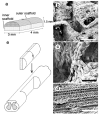Cell therapy for spinal cord regeneration
- PMID: 18029050
- PMCID: PMC2225623
- DOI: 10.1016/j.addr.2007.08.028
Cell therapy for spinal cord regeneration
Abstract
This review presents a summary of the various types of cellular therapy used to treat spinal cord injury. The inhibitory environment and loss of axonal connections after spinal cord injury pose many obstacles to regenerating the lost tissue. Cellular therapy provides a means of restoring the cells lost to the injury and could potentially promote functional recovery after such injuries. A wide range of cell types have been investigated for such uses and the advantages and disadvantages of each cell type are discussed along with the research studying each cell type. Additionally, methods of delivering cells to the injury site are evaluated. Based on the current research, suggestions are given for future investigation of cellular therapies for spinal cord regeneration.
Figures


References
-
- National Spinal Cord Injury Statistical Center Fact Sheet . National Spinal Cord Injury Center; Jun, 2006.
-
- Fawcett JW, Asher RA. The glial scar and central nervous system repair. Brain Res Bull. 1999;49:377–91. - PubMed
-
- McGee AW, Strittmatter SM. The Nogo-66 receptor: focusing myelin inhibition of axon regeneration. Trends Neurosci. 2003;26:193–8. - PubMed
-
- Myckatyn TM, Mackinnon SE, McDonald JW. Stem cell transplantation and other novel techniques for promoting recovery from spinal cord injury. Transpl Immunol. 2004;12:343–58. - PubMed
-
- Busch SA, Silver J. The role of extracellular matrix in CNS regeneration. Curr Opin Neurobiol. 2007;17:120–7. - PubMed
Publication types
MeSH terms
Grants and funding
LinkOut - more resources
Full Text Sources
Other Literature Sources
Medical

